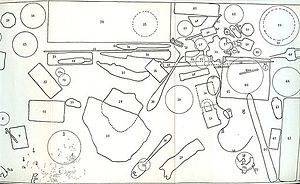My bot – “Rhyme and Punishment” (@Crimeaandpun – political pun intended) and the hashtag is #Dissident – posts verse from dissident poets every 15 minutes. What is currently operating is a very imperfect and incomplete version of what I’d like to do.* My hope was to create a bot that, in addition to tweeting poetry, would retweet and also respond to other people’s tweets that included trigger words and/or the same hashtag. But I had so many technical difficulties getting this project up that I scaled back that idea and cheated by signing my account up for a free service that re-tweets posts that have a common hashtag (#Dissident). I picked this hashtag because I assumed it would be fairly common these days. I chose poetry in translation by a Russian writer from the early 20th C, Marina Tsvetaeva (who was anti-Bolshevik), two contemporary Syrian poets, Amira Abul Husn and Housam Al-Mosilli, and a Chinese poet, Liu Xia (who is married to dissident Liu Xiaobo). The face of Rhyme and Punishment is Vladimir Putin. It all seems a bit pretentious, I know, but I wanted to see what it would look like if I threw together writers who are or were persecuted by their respective governments for their politics with a contemporary political figure who has a reputation for doing just that, and who is widely condemned by most advocates of democracy (with the exception of our president-elect).
The other thing I did was have my bot follow a few organizations and media outlets that are popular with some of the more Right-leaning and/or Trumpian contingent on Twitter: the CIA, the FBI, Homeland Security, Ann Coulter, several Tea Party groups, the Daily Caller, Breitbart News, and even the Grand Old Party, which seems relatively benign among these others. Most of these are entities are what I would personally consider on the “despotic” end of the ideological spectrum, and I wanted to see how many followers Rhyme and Punishment could attract from this pool of Twitterers. So far, four – all of which I am sure are bot-driven themselves, in order to attract more followers. (If they were individuals they would probably notice that R&P is not their political cup of tea.) So you could say that R&P is baiting a certain Twitter demographic as an adjunct to this experiment – what affinities trigger which followers?
Keeping a search open for all tweets with the hashtag #Dissident, as well as account names that include the word Dissident, yields surprising results. In the past three days, my bot has tweeted more of its own material with the hashtag than any other account on Twitter. I did not expect that. The poetry includes the hashtag at the end of every sentence, not every line, in order to create some discontinuity in the results of such a search. I reset my tweets 15 minutes apart so that other #Dissident tweets would be more frequently interspersed. But even reset 30 or 45+ minutes apart, there has been no significant increase. Why is this such an unpopular hashtag at a time like this? It’s interesting, nevertheless, to see what else is tweeted, and from which countries. Some of the tweets are ads. Most of the others are not from the U.S. I wonder, of course, if anyone has done a similar search and discovered Vladimir’s tweets, but so far no one has responded. I would say that this experiment has yielded very mixed results. Then again, I didn’t approach it with any assumptions about what would happen.
* I struggled with a very long time on my own — too long — to get a Twitterbot script to work before I was able to sit down with a Digital Fellow (fortunately, bot-expert Patrick Smyth) and get some help. (Greg had also offered some suggestions via email, but I didn’t have any luck.) Even with Patrick’s help, I spent hours afterward working on it. I won’t lie – the whole process has been extremely frustrating, not to mention distressingly time-consuming given everything else I have going on in my life. However, creating Twitterbots with more sophisticated functions is something that I’d like to continue doing from time to time, once I can master the coding.




